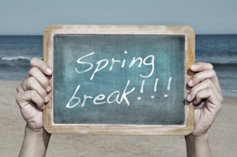Guide to a Sober and Safe Spring Break

Spring Break is typically a one-week escape from school life. Oftentimes, it coincides with Easter, occurring in March or April. It is an opportunity for university and college students to go home, see family or just take a holiday. Spring Break is also a time when students flock to a variety of leisure vacation spots, typically by the beach where it is warm and sunny.
Spring Break Today
A popular destination for spring breakers is the beautiful beaches of Florida. The more adventurous may head for Mexico. Regardless of destination, Spring Break poses its own challenges to sobriety, and safety.
Out-of-control parties, overindulgence in alcohol, binge drinking, marijuana, designer drugs, hard drug use—all the high-risk activities which pose a real danger to safety and well-being–are now a part of Spring Break.
In Panama City Beach, Florida, the “100 milers” arrive for Spring Break. Not college students at all, but adults in their 40’s who come from miles away to deal drugs, steal, and take advantage of young women foolish enough to be drunk or high.
According to one Fox News reporter who went to Panama City Beach last Spring Break to film and interview students, “it’s been taken to a dangerous level” in recent years.
A Sober and Safe Spring Break
While not all spring breakers indulge in the level of partying as those on Panama City Beach, there are basic safety and sobriety measures that go far in keeping Spring Break an enjoyable holiday.
The following guide can help you; your friends and your loved ones stay safe—and sober. While no alcohol and no drugs is always the safest and best choice, there are guidelines to follow if you do drink.
- Let family and friends know your Spring Break destination and travel plans. Your expected departure date and time, and return date and time should be known to them.
- Keep your valuables safe. Secure them in the hotel safe, or the locked trunk of your car.
- Use extra caution when using the ATM. Use it in daylight hours, and have at least one friend with you.
- Choose alternate activities to partying. Enjoy your vacation destination surroundings. Participate by sightseeing, dining-out, attending art or sporting events, or shopping destination-unique shops or markets.
- Enjoy destination-related activities. A warm, beachside location invites beachcombing, swimming, sunbathing, or beach volley ball. A cold weather location invites skiing and other cold-weather sports. Each destination has its own special qualities and points of interest.
- Drink mocktails: non-alcoholic beverages in the form of strawberry daiquiris or piña coladas. Many alcoholic mixed drinks—minus the alcohol– can be enjoyed. Get creative and enjoy.
- If you traveled out-of-state for Spring Break, and intend to drink alcohol, familiarize yourself with drinking laws in your destination state. Know open container law and underage drinking laws, minimally.
- If you do drink, be responsible.
- Set your limits before you attend a party, and stick to them. Know beforehand if you plan to drink, and how much.
- Do not drive if you have been drinking. Plan ahead for a designated driver to take you and your friends back to the place you are staying.
- Come with your friends–leave with your friends is the rule. Watch-out for each other. Don’t leave with someone you do not know, and don’t let one of your friends do it, either. Stay together, enjoy sharing the Spring Break experience—and go home together, safe and sound.
Following these simple, common-sense guidelines can help you and your friends enjoy a safer and sober Spring Break.


